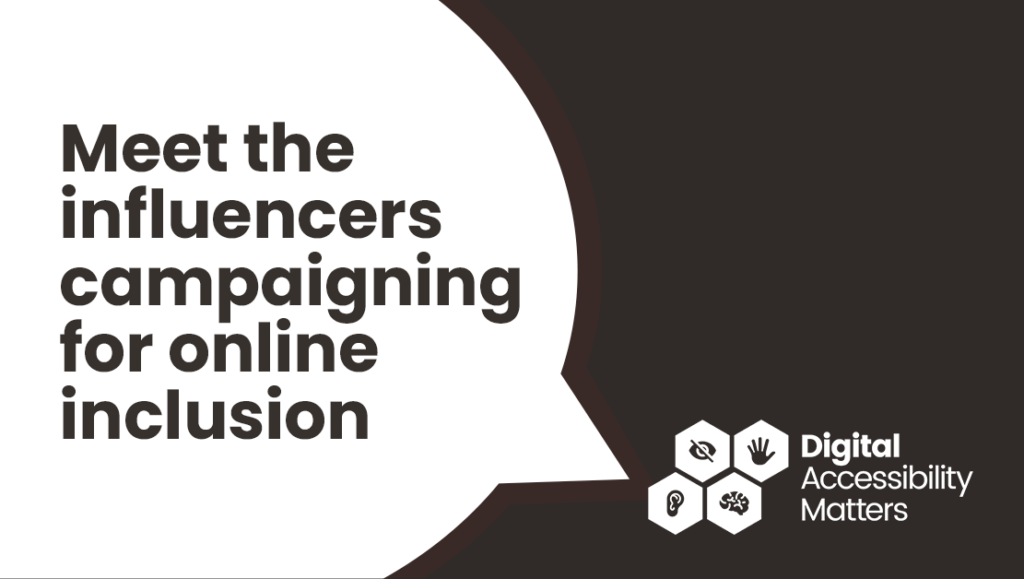When considering accessibility, the first things to spring to mind are lifts, ramps, and accessible bathrooms. However, there is another element to accessibility that arguably impacts a greater number of people, but is often overlooked; digital accessibility.
As a society we are growing increasingly dependent upon technology, yet it remains inaccessible for so many. That’s why campaigns such as HeX Productions “Digital Accessibility Matters” matter. They approached me with some questions about my views and experiences of digital accessibility, which I’ve answered below!
What does good digital accessibility mean to you personally?

Personally, I don’t need tools such as alt text or captions, but there are other things I find incredibly useful. I am particularly prone to headaches, which can be brought on by bright lights. Therefore, I find having the option to turn on a “dark mode”, or something that dims bright white to a softer cream, is crucial to being able to spend time working on a computer without developing a headache.
I also find having information interspersed with images, or broken up into smaller segments with headings and bullet points much easier to process due to “brain fog”, the confusion and concentration issues so common in chronic illness. It’s no good being able to physically access information if you can’t process it!
What are the common barriers to digital accessibility that you face and how are you impacted by these?
People don’t know about digital accessibility, or the tools that are out there to implement accessible practices. Alt text and image descriptions for screen readers are always hidden away behind different settings in each website and app, making it difficult to consistently provide alt text across all platforms.
There is also sometimes a cost barrier to digital accessibility; Zoom is not the only corporation to hide captions behind paywalls, and software such as speech-to-text isn’t cheap. For independent and self-funded creators, this is particularly difficult to get around.
If being accessible online was, ironically, made more accessible both in cost and ease, I’m sure more people would engage with it.
What are your top three digital accessibility must haves?
My top three must haves are, in no particular order:
- The ability to change colours. This helps people with different types of colour-blindness, dyslexia, and people like myself who struggle with headaches.
- Alt text on images and gifs (and descriptions of videos).
- Captions on videos.
Have you ever found it impossible to access information on a website and what do you do in those circumstances?
My work in clinical trials quite often involves looking at the latest articles in various scientific journals, and these are often incredibly inaccessible. The text is usually very small, and clustered together in huge chunks making it difficult to pick out the important information. Often the background is bright white and cannot be changed. I usually to printing out articles to avoid the glare of bright white screens, and grabbing a highlighter to pick out the important information, but I’d much rather be able to read it online and save paper!
If you had the chance to make one point to an organisation considering changing their website, what would it be and why?
Digital accessibility is a must-have, not a desirable. Furthermore, the bigger the organisation, the less excuse there is for having lapses in accessibility. Accessibility should be kept in mind during every step in the design process. Fancy graphics may look pretty, but they must not take precedence over being able to access the information in the graphic.
Have you noticed a change in recent times with accessibility? In particular, since the public sector legislation changed in the UK in 2020?
Since the change in legislation in 2020, I have seen more options such as “dark mode” being treated as standard features rather than extras, and there have definitely been more images with alt text included. Captions on videos are still somewhat lacking, more often than not the videos on my social media feeds aren’t captioned, although I am quite impressed with how easy TikTok makes it to caption videos.
Much like accessibility in the “physical” world (for want of a better term), more people are aware of the tools that make life more accessible for disabled people, but there are still huge gaps in what can actually be accessed. That said, I’m not sure how many people even knew that UK legislation was changed in 2020, but campaigns like Digital Accessibility Matters should help change that!
Final thoughts
I’m incredibly proud to have been asked to advocate on a campaign such a Digital Accessibility Matters, especially as I know I have let people down in the past when it comes to the accessibility of my content. I’m trying to shift my thinking on the subject to consider tools like alt text to the equivalent of a ramp or a lift; critical tools that enable disabled people to live richer, fuller lives.
Visit the Diary of a Disabled Person website.

